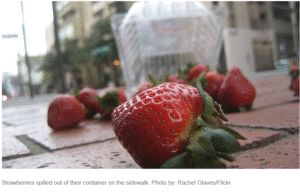I’ve long believed the five second rule was some phrase made up to overcome the guilt in eating things that dropped to the floor, especially coveted morsels.
Now check out this Newsela article by Gavin Haynes, The Guardian, adapted by Newsela staff with some scientific research into this seemingly light weight assertion that it’s OK to eat off the floor.
———————————————————————————————————————————
For as long as anyone can remember, humankind has believed that any food item dropped on the floor can still be eaten, as long as it was on the floor for less than five seconds. It is almost as if Moses came down from Sinai with a stone tablet bearing the five-second rule.
Of course, there are still rebels who say that floors are consistently unclean. They think that if food spends any time on the floor it becomes unsafe. Then there are those who are just happy to take their chances. But lately, scientists have been trying to get in on the act.
Copernicus flipped long-standing beliefs in the 1500s by pointing out that the Earth revolved around the sun instead of the other way around. Like him, these scientists are flipping over an ancient belief system. This is the belief system surrounding buttered toast.
Different Food, Different Dirt, Same 5 Seconds
Anthony Hilton, a professor at Aston University, will speak at The Big Bang Fair in Birmingham, England. He is a professor of microbiology, or tiny organisms, including germs. The fair is Britain’s largest celebration of science, technology, engineering and math for young people. Hilton says that different foods can pick up different amounts of dirt from the floor in just a few seconds. He says that sandwiches, potato chips, dry toast and cookies can all chill out on the floor for half an hour. When picked up, they will do no harm to the eater. But candy, cooked pasta and doughnuts are different. They can get contaminated, or pick up harmful dirt or germs, in just about five seconds. Hilton also found that tiled surfaces are dirtier than carpets.
These findings might be astonishing to humans trying to understand the effects of pasta spillage. However, there is a more amazing fact in the story. It is that looking into the five-second rule has become something of an industry for modern researchers.
Maybe Science Is Oversimplifying Things
In 2003, Jillian Clarke established the power of the five-second rule to attract media attention. Clark dropped gummy bears on the floor. The ones dropped on rough tiles and left for five seconds, would pick up more bacteria than those left on smooth tiles for the same amount of time.
Rutgers University concluded in 2006 that the five-second rule was a “significant oversimplification.” In 2007, Paul Dawson of Clemson University concluded in the Journal of Applied Microbiology that the dirtiness of the floor is much more important than how long the food rests on it. Dawson also agreed that dropping food on carpet left it much cleaner than dropping it on tiles. There was only with 1 percent contamination with carpet compared with 70 percent on tiles.
In 2014, Aston University announced that when food hit the floor, it instantly picked up at least some bacteria. However, the amount of dirt stuck to the food increased tremendously in the period from three to 30 seconds after landing.
The Germs Below
All of this is may be fascinating to people who worry about germs, or who tend to drop their food on the floor frequently. But for the rest of us, it just looks like a smart form of cooperation between researchers and journalists. The researchers are trying to get their somewhat dry findings to a wider audience. The headline writers want to make the researchers’ dull-sounding facts more exciting for their readers.
The biggest story never told in five-second rule headlines is that it does not matter either way. It is true that contamination of food from dirty cooking tools is a leading cause of food poisoning. Using unwashed knives that have cut raw chicken to cut raw vegetables can make people sick. However, good food landing on a fairly clean floor has seldom harmed anyone.
Hilton’s study covered typical floor types in bacteria. However, he found that dropped food picked up no more than 0.0004 percent of it.
Is the five-second rule dead, then? As the great religions have already found, it takes more than a few scientific facts to kill off our deep desire to believe.
_____________________________________________________________________________
FOR TEACHERS:
Ask your learners what they think about the five second rule before reading or showing them this article.
There is a quiz and modifications of the article to suit readers from various levels throughout the primary and secondary levels.

